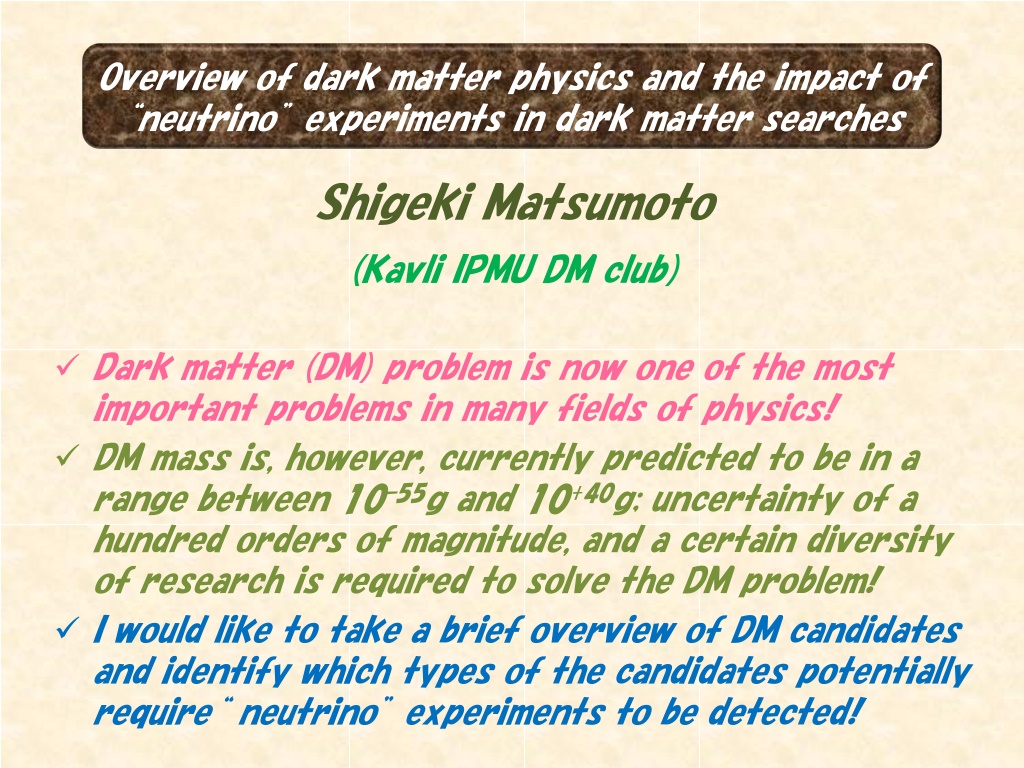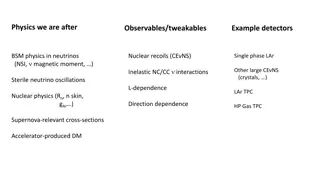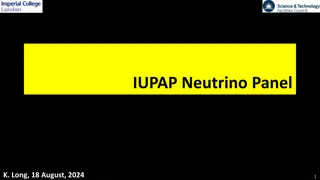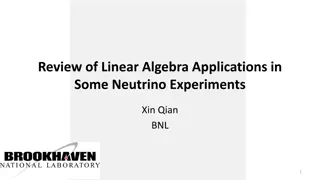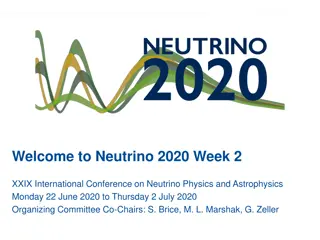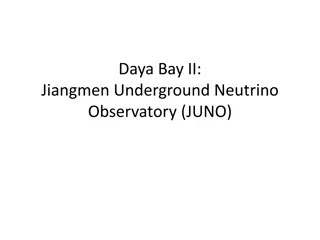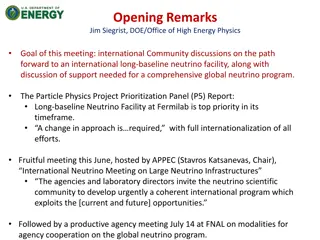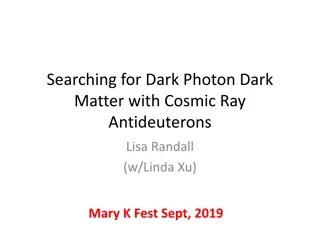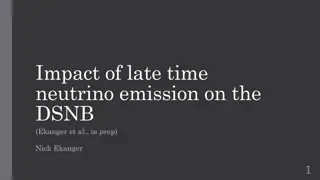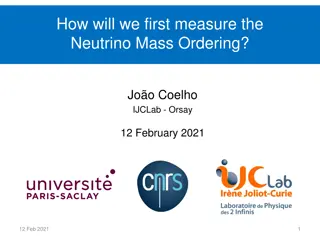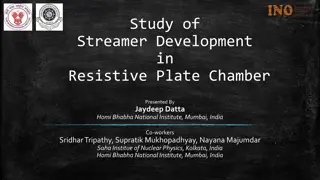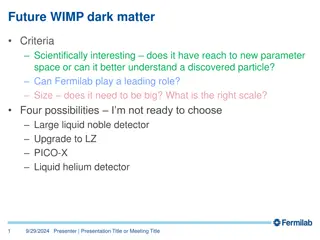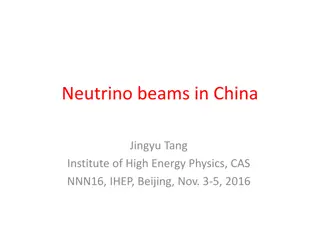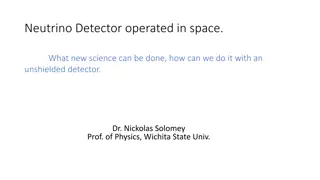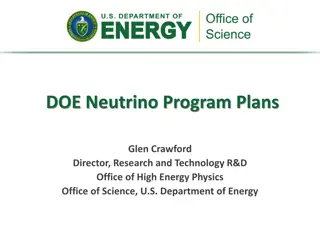Overview of Dark Matter Physics and Neutrino Experiments
The search for dark matter (DM) is a crucial challenge across various physics fields due to the wide range of predicted masses and uncertainties. DM candidates include stable, neutral, cold, and weakly interacting particles, with potential types like axions, SIMP-like, and WIMP-like DM. Neutrino experiments play a key role in detecting DM, especially in cases of non-thermal DM candidates motivated by PeV events. These experiments help in understanding DM interactions and its impact on astrophysical phenomena.
Download Presentation

Please find below an Image/Link to download the presentation.
The content on the website is provided AS IS for your information and personal use only. It may not be sold, licensed, or shared on other websites without obtaining consent from the author. Download presentation by click this link. If you encounter any issues during the download, it is possible that the publisher has removed the file from their server.
E N D
Presentation Transcript
Overview of dark matter physics and the impact of neutrino experiments in dark matter searches Shigeki Matsumoto (Kavli IPMU DM club) Dark matter (DM) problem is now one of the most important problems in many fields of physics! DM mass is, however, currently predicted to be in a range between 10 55g and 10+40g; uncertainty of a hundred orders of magnitude, and a certain diversity of research is required to solve the DM problem! I would like to take a brief overview of DM candidates and identify which types of the candidates potentially require neutrino experiments to be detected!
1/7 Dark matter (DM) candidates Dark matter exists in the form of a halo associated with a galaxy, etc. Dark matter should be (almost) stable, neutral, cold & weak interacting. 10 22eV < m < 1040g What is DM? Eg. PBH 10 22eV < m < 1019GeV Particle Non-particle Motivation! Eg. Axion, R, Fuzzy DM, 10 2GeV < m < 105GeV Thermal Non-thermal Motivation! Asymmetric Freeze-out SIMP-like Semi-ann. WIMP-like DM DM DM SM DM DM SM SM 3DM DM DM
2/7 DM detections & neutrino experiments Various experimental/observational strategy to detect a particle DM! Direct detection @ Underground laboratories Observing signals based on collision among DM & a nucleon (electron). It is sensitive to interactions between DM & quarks, gluon, electron. Detection @ particle colliders (LEP, LHC, ILC, CEPC, FCC) Observing missing momentum signals from a process producing DM. It is sensitive to interactions between DM & quarks, gluon, electron. Indirect detection @ telescopes & observatories Observing various signals emitted by DM annihilation/decay in space. It is sensitive to various interactions between DM and SM particles. DM SM Charged products (e, p, ) CR obs. Non-charged prods. ( , s) obs. Similar amounts of & are produced, observing g ray has usually advantage. Lepto (neutrino) philic dark matter. Ann Ann SM DM SM DM Dec Dec (Neutrino observatory plays an important role to detect DM trapped inside a star.) SM
1/7 Dark matter (DM) candidates Dark matter exists in the form of a halo associated with a galaxy, etc. Dark matter should be (almost) stable, neutral, cold & weak interacting. 10 22eV < m < 1040g What is DM? Eg. PBH 10 22eV < m < 1019GeV Particle Non-particle Motivation! Eg. Axion, R, Fuzzy DM, 10 2GeV < m < 105GeV Thermal Non-thermal Motivation! Asymmetric Freeze-out SIMP-like Semi-ann. WIMP-like DM DM DM SM DM DM SM SM 3DM DM DM
3/7 Case in Non-thermal DM DM candidates motivated by IC PeV events. DM interpretation of the events was already started just after the first IceCube report . DM decay to a neutrino pair with the lifetime of O(1029)s can fit the data together with a continuous astrophysical contribution), w/o conflicting with gamma-ray date; Fermi-LAT. [B. Feldstein, A. Kusenko, S. M., T. T. Yanagida, 2013] [M. Chianese, et. al, arXiv:1907.11222] For the latest result of the interpretation What kinds of physics we can think about behind this DM candidate? DM mass of O(1)PeV is too heavy for the thermal DM, so it should be inevitably a non-thermal DM! Possible models behind the PeV DM: Gravitino DM @ SUSY (RPV+B L) Decay Operator: Non-abelian hidden gauge boson Decay Operator: Singlet fermion DM @ RS setup Decay Operator: Possible production scenario of the nonthermal DM in the early universe is Freeze-in, assuming e.g. that TRis enough below mDM.
4/7 Case of EW scale WIMP DM Leptophilic WIMP is not well-charged yet and waiting for our search! For example, in the case of the SM singlet and fermionic WIMP, [S.M., S. Mukhopadhyay, Y. S. Tsai, 2016] (Flavor blindness & CP invariance assumed.) Even in future, the leptophilic WIMP region will remain uncarted at EW! Present status Possible near Present status & No CPV interaction & Present status & Future prospects Future prospects Future prospects Present status future prospect The region is potentially tested by Future lepton colliders CR positron observations Neutrino observatories 3 Notice that neutrino observatories work for Dirac F or Vector WIMP! Final state: Jz= 1 (Lz= 0 & Sz= 1) Initial sate: Jz= 0 (Lz= 0 & Sz= 0) @ Scalar DM Jz= 0 (Lz= 0 & Sz= 0) @ Majorana DM Jz= 0, 1 (Lz= 0 & Sz= 0, 1) @ Dirac DM Jz= 0, 1, 2 (Lz= 0 & Sz= 0, 1, 2) @ VDM DM DM Annihilation into a pair of neutrino @ NR limit.
5/7 Case of Heaviest WIMP DM Thermal dark matter GeV 105 10 3 WIMP having the largest annihilation cross section (unitarity limit). Composite WIMP (baryon) in a hidden sector which is governed by a strong gauge theory. (DM stability is guaranteed by U(1)Bhidsymmetry.) SU(3)hidCase [R. Huo, S.M., Y. Tsai, T. Yanagida, 2016] DM mass: mDM= 150TeV with DM h2= 0.12. Composite baryonic WIMP is not necessarily to be absolutely stable! L = (1/32 )(0.1)2mDM5/mpl4= 10 52 GeV DM lifetime: DM= O(1027) s, which is comparable to the current sensitivity. L DM From matrix element (Decay through Dim6 operator)
6/7 Another thermal DM! [M. Ibe, SM, T. Yanagida, 2012] Case of Asymmetric DM B-L asym. generated @ Tlept (DM is in chemical eq. with SM.) DM & SM decoupled @ Td Sphaleron decoupled @ TEW DM & Anti-DM ann. @ Tann There are DM & Anti-DM particles. DM particle is charged under U(1)B L. Its mass is O(1)GeV for abundance. Large annihilation among DM & DM. There is an interaction exchanging B L asymmetry between DM & SM. DM seems a composite particle (baryon) in a hidden sector!! Conditions written in the left panel are naturally satisfied!! Composite baryonic ADM is not necessarily to be absolutely stable! q q Sign[(B-L)DM] = Sign[BSM] is proved! [H. Fukuda, SM, S. Mukhopadhyay, 2015] Positive B-L charge carried by ADM. DM decay involves e+, e , p, p, , , B L is not carried DM The so-called the ADM interaction induced the decay of ADM particle!
7/7 Summary I have briefly overview of DM candidates in the market and introduced several candidates that potentially require neutrino experiments to be detected. The keyword is the leptophilic (neutrinophilic) dark matter: DM candidates Motivation How to test it? PeV-scale DM IceCube events More IceCube events EW WIMP DM WIMP miracle Line- & lepton colliders DM stability O(100)TeV detection Heaviest WIMP Asymmetric DM Cosmic coincidence Anti-v detection Last three candidates are thermal DM candidates and thus motivated from the viewpoint of cosmology in addition to those mentioned above.
